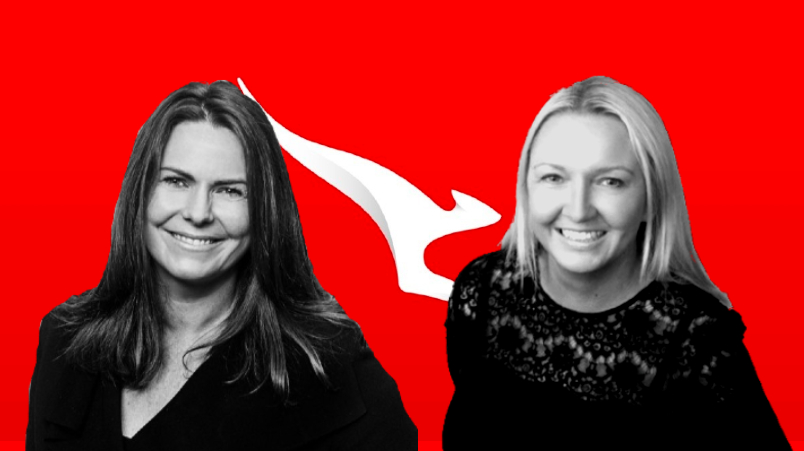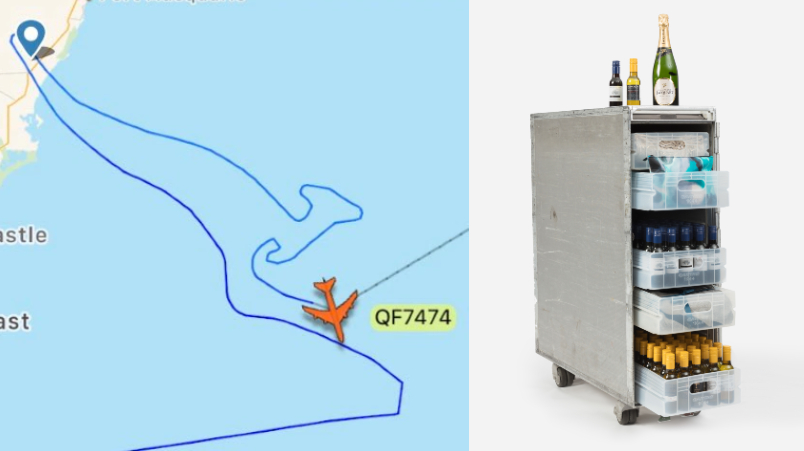Qantas reveals new CMO, marketing restructure, 'zero' marketing budget and a Covid cash scramble selling bar carts, pyjamas; accelerates in-housing

"We didn’t have any budget. As in, zero marketing budget,” former Qantas Chief Customer Officer Steph Tully (R) said. “So how do we do things that are good for keeping that connection with our customers?” Left: Petra Perry.
Qantas has quietly restructured its marketing team and appointed a new CMO to replace former chief Jo Boundy, now at Commbank. Petra Perry has been named CMO of both the airline and its loyalty program after almost two years leading the latter. Former CMO and current Qantas Chief Customer Officer Steph Tully told the ADMA Global Forum yesterday the airline pulled out all the stops to stay afloat during Covid with new - and used - products flying off the e-commerce shelves. The flightless airline shifted pyjamas, bar carts, sold out of round trips to nowhere and made $10 million ads on shoestring budgets. It kept its magazine going so its publishing partner, News Corp-owned Medium Rare, could do the same, selling ads and staying connected with frequent flyers. Tully says Qantas is not yet out of the woods but there is optimism.
What you need to know:
- Qantas has named Petra Perry as its new Chief Marketing Officer, consolidating its Loyalty and Airline marketing under one person. Previously, they were separated and Perry led the Loyalty component.
- Chief Customer Officer Stephanie Tully told the ADMA Global Forum yesterday about the many creative ways the company kept solvent over the past two years. It slashed its marketing budget, sold inflight bar carts and pyjamas, sold flights to nowhere, and turned its magazine into a digital product for Frequent Flyers.
- It has been “the worst crisis Qantas has felt in its 100year history”, Tully says. “And it’s not over”.
- The entire marketing team has restructured, it has a much smaller budget, and the company has cut its workforce from 30,000 to 20,000.
We didn’t have any budget. As in, zero marketing budget... So how do we do things that are good for keeping that connection with our customers?
Flights to nowhere, magazines for frequent flyers, a kangaroo-shaped flight path, pyjamas, and in-flight bar carts for sale: Qantas did everything it could to stay alive over the past couple of years, the group’s Chief Customer Officer, Stephanie Tully, says. And the company’s worst crisis in 100 years is not over yet.
“We can’t fly to China. We can’t fly to Hong Kong. We can’t fly to Japan,” she said. “We’re far from normal, but it does feel like it’s a bit more optimistic for us.”
The company has named a new Chief Marketing Officer, replacing Jo Boundy who left earlier this month to take up the corresponding gig at CommBank. Petra Perry, previously the CMO for Qantas Loyalty, quietly stepped into the newly created combined role covering Loyalty and the Airline.
Qantas has restructured in the face of $20 billion in lost revenue – there’s a lot more in house, and a much smaller budget.
“There’s no difference to our customers in those things (loyalty and airline), but we acted quite separately,” Tully told the Association for Data-Driven Marketing and Advertising’s (ADMA’s) Global Forum in Sydney yesterday.
“We definitely built up our in-house capability because the speed we needed to talk to our customers over the last two years, the content we needed to create – I know agencies will hate me for this, but doing it internally was sort of the only option we had from the cost and timing perspectives. So building that capability, which is really best in class I think, that has been a big change for us as well.”
How to save an airline
When Australia’s borders slammed shut in March 2020, it was, to put it mildly, a big day in the Qantas boardroom. But Tully said management made a few key decisions early. One, they wanted to keep the brand “alive” in the hearts and minds of customers.
“But obviously, we didn’t have any budget. As in, zero marketing budget,” she said. “So how do we do things that are good for keeping that connection with our customers?”
They decided to keep the Qantas magazine alive, for starters. While most airlines shafted theirs, Qantas kept it. Its 2020 Media Kit says it has 393,000 readers with an average income of $124,000. Instead, Qantas sent out digital editions and physical copies to Platinum and higher frequent flyer members.
"It's one of the most-read, physically remaining publications in Australia and we also have a brilliant partner in Medium Rare that makes that for us that we were concerned about their business as well," she said. Medium Rare is a News Corp content agency.
"That kept enough advertising revenue coming in that our magazine partner could stay in business. And it also helped engage our customers."
Most of the ideas Qantas had served two goals. It kept the brand in the minds of consumers, and kept key people employed.
“We sold pyjamas, we sold our bar carts. That was obviously again good to keep the brand alive for our customers. The bar carts sold out really quickly,” Tully said.
Qantas had 1,000 bar cards from the Boeing 747, which were being retired, and packed them full of wine, snacks and candy. They sold out in two hours.
“I hope some of you bought some – but also, we didn't need them anymore. So it was good for the business for us to get a bit of money for that stock,” Tully said.
They carried out flights to nowhere, which simply took off from an airport, flew around, and landed at the same airport. They sold out in 15 minutes. The flights, which added some revenue, served a dual purpose of keeping flight attendants, pilots, engineers and ground crew up to date with their training, which solved another of the airline’s problems.

Qantas flew its final Boeing 747 in the shape of a kangaroo and put its former bar carts, above right, up for sale.
I think we underestimated how much people care about their frequent flyer status.
People love their frequent flyer memberships
Likewise, Qantas kept its Frequent Flyer loyalty club connected. “I think we underestimated how much people care about their frequent flyer status,” Tully said.
“Every time we did it, we said hopefully it's the last time, but we've done it three times to extend people's much well-earned frequent flyer status, be at Platinum or Silver, whichever tier you're in… The frequent flyer program did a great job of keeping our 12 million members connected so that they could earn points that they ultimately mainly want to use for travel.” It also repositioned around being a “frequent dreamer”, rather than a flyer.
Previously expensive campaigns for less
There have been several key ad campaigns over the past two years. But Tully said they had a problem: How to pull off big, inspiring ads on a shoestring? Previously an ‘I Still Call Australia Home’ ad might cost $10 million. But the company had, over the past two years, had to pay out, change or credit 10 million separate bookings. It had lost $20 billion in revenue.
An ad about people going travelling again, updating expired passports and getting rewarded for being vaccinated drove 700,000 people to apply for the rewards, Tully said, and Australia Post offices reported passport renewals soared.
“I’m really proud of Jo Boundy and the marketing team, producing that in three weeks with very little cash,” she said.
“The best join for frequent flyer we’ve seen in a long time and we also got people renewing their passports, which is clearly important for us as well.”
She said some of the media was donated by media owners for the ad as they saw why it was an important message to share. “There is some self interest in their benevolence,” she said, “which was fantastic for us.”
